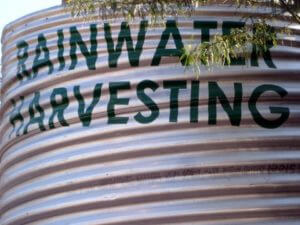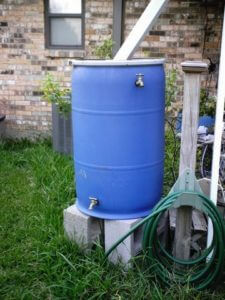Rainwater Harvesting, a Green Alternative to Watering Plants

By harvesting rainwater, you conserve water and help protect groundwater resources. It is a sound sustainability measure that harvests a natural, free source of water and uses it to irrigate your landscape plants. It is also clean and pesticide- and salt-free.
Rainwater can be collected from the roof of your house and stored in catchment basins for later use. It can be directed to a specific area in the yard or to a storage container. The amount of water collected from a roof is dramatic. Rainwater is an excellent way to irrigate landscape plants as well as to add water to ponds, water features, or birdbaths. When you harvest rainwater, you can also reduce flooding-related erosion in your landscape, and channel a beneficial resource to your landscape plants. Rainwater contains natural and organic nutrients that are essential for plant growth. Salts that naturally accumulate in the roots of plants can be leached through the soil and away from the root zone with rainwater. Notice how plants respond and grow after a strong summer monsoon.

In a simple earth grading system, water can be channeled directly to landscape plants by making small berms, which are depressions or basins that direct runoff onto your plants. Using creative grading helps deliver substantial amounts of natural water to plants. This method is extremely useful when landscaping with native or drought-resistant vegetation, since these plants are adapted to seasonal supplies of water. When designing a new landscape, consider all possible grading methods to capture rain runoff. Look for the high and low areas where water flows after a heavy rain. Construct drainage swales or soft, sloping trenches to direct rainwater toward vegetation and basins in the yard. Create berms around large, mature trees to hold the water in their tree wells. Berms can be extended beyond the tree’s canopy zone as it matures and grows.
Boomerangs are kidney-shaped berms of soil designed in an arc or crescent shape rather than a closed circle. They are designed to be staggered down from the top of a slope about thirty degrees from the top to the bottom and help slow down the water during a heavy rainfall. When rainwater begins to accumulate at the top of a boomerang, it will soak in but continue to flow downward to the next plant down the slope. Watch and observe how water flows throughout your yard during a heavy rain and start to construct and utilize these patterns to control drainage in your landscape areas.
When using water harvesting systems, you will need to perform some degree of maintenance. The systems can expand as the plants mature. Determine areas that are receiving adequate water and areas where water can be better distributed to plants. During seasons of heavy rain, you might find areas in the yard that benefit from water harvesting. Always inspect the system to keep it at its best operating performance and expand it when new plants are added or landscape plants mature.

Construct a system that produces and maintains high quality water. Gutters, downspouts, or pipe used to direct the water must be kept clean and free of leaves and debris. Do this by screening or filtering any unwanted particles. A simple screen or mesh can be made to filter the water coming out of the downspout. If the water collected is clean, then it can be used for other uses at a later time. Always screen all inlets and outlets to the tank to prevent mosquitoes from entering and breeding. Design an access link to the tanks for routine maintenance.
Collected rainwater can be stored for later use in several different containers or tanks. A container can be as simple as a fifty-five-gallon steel drum, plastic garbage can, metal barrel, or tank made from fiberglass, wood, metal, or polyethylene. There are many water harvesting companies locally and online where you can purchase products to construct your own system or have a professional install the entire system. The storage tank and rain gutters are usually the most expensive items in the water harvesting system. When choosing the tank, consider your budget and space requirements.
Storage holding tanks are placed either above or below ground level and should be located near downspouts. Several smaller tanks or cisterns can be used together for water storage. The cost to install a tank below ground is more expensive. You may need to hire someone to dig the hole or rent a backhoe to dig an area big enough for your underground unit of choice. An underground system also requires a pump to remove the water from the tank for distribution. Tanks should be easy to access and maintain. If the tank is buried, it should be in soil with good drainage.
 Above ground tanks can be hidden behind plant materials or creative metal screening to conceal them. The storage tank should be in an area that takes advantage of positive gravity flow, eliminating the need for a pump. Install a faucet on the cistern or tank. If a hose is attached, you can manually water plants and direct water to needed plants. Keep the holding tank closed from sunlight, insects, and possible critter infestation. Sealed containers will not grow algae or bacteria. Keeping the tank closed also prevents mosquitoes from laying eggs and hatching in your water site. Another benefit of sealing is that less water will evaporate—just be sure to design an adequate venting system on top of the tank to prevent a vacuum from forming when large amounts of water are removed from the tank at one time. Have a four-inch sludge layer on the bottom of the tank, too. Do not use water from this area because it could clog the supply pipes; instead, install the water spigot above the sludge layer.
Above ground tanks can be hidden behind plant materials or creative metal screening to conceal them. The storage tank should be in an area that takes advantage of positive gravity flow, eliminating the need for a pump. Install a faucet on the cistern or tank. If a hose is attached, you can manually water plants and direct water to needed plants. Keep the holding tank closed from sunlight, insects, and possible critter infestation. Sealed containers will not grow algae or bacteria. Keeping the tank closed also prevents mosquitoes from laying eggs and hatching in your water site. Another benefit of sealing is that less water will evaporate—just be sure to design an adequate venting system on top of the tank to prevent a vacuum from forming when large amounts of water are removed from the tank at one time. Have a four-inch sludge layer on the bottom of the tank, too. Do not use water from this area because it could clog the supply pipes; instead, install the water spigot above the sludge layer.
Check the holding tank often. Inspect water levels in the tank to detect possible leaks. Check downspouts for blockage of leaves and debris. Observe the system after a heavy rainfall. Make sure your tank or cistern is big enough for the amount of water to be collected. Overflow water should be put to beneficial uses, too. Install an overflow pipe in the tank because during seasons of maximum rainfall your tank or cistern might not be able to hold all the water produced in a major downpour. Have overflow pipes designed to distribute water to thirsty plants nearby. The overflow pipe should be the same size as the inflow pipe; if the downspout is a four-inch pipe going into the cistern, then the overflow pipe should also be four inches. Create spillways and direct them to provide an overflow route for the water to reach your plants.
If you are ecologically savvy, rain harvesting systems are an excellent way to irrigate plants and supply water to people and animals. It can save you time and money on your monthly water bills. You also reduce your dependence on municipal water and help to become a “greener” homeowner. The system can be simple or sophisticated, and you can install it yourself or hire a local company to give you a bid to install the entire system. By harvesting a natural source of water, you are helping to conserve a precious resource.

